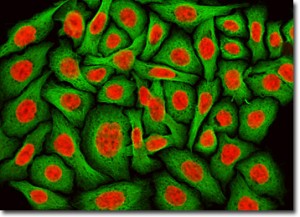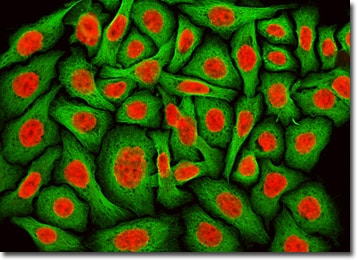
In 1951, 31 year old Henrietta Lacks was diagnosed with cervical cancer, which she died from within the year. Unknown to her and her family (without informed consent) a surgeon took a tissue sample from her tumor that was passed on to a Dr. George Gey. A scientist for the John Hopkins University Tissue Culture Laboratory, Gey propagated Lacks’ tissue sample into an immortal cell line – the HeLa cell line.
The cells from Lacks’ tumor have an active version of the telomerase enzyme (telomerase is the mechanism by which cells age or are aged) and proliferate abnormally fast. On the day of Henrietta Lacks’ death, Dr. Gey announced to the world that a new age in medical research had begun – one that might provide a cure for cancer.
HeLa cells were utilized in 1954 by Jonas Salk to develop the cure for polio. Since then they’ve been used in researching cancer, AIDS, the effects of radiation and toxic substances, and for mapping genes, among other things.
Today, the HeLa cells are so common in laboratories that they contaminate many other cell cultures and have rendered some biological studies invalid through their presence. There are also more HeLa cells alive today than when Henrietta Lacks was alive – they outweigh her physical mass by many times.
Tragically, Lacks was never told of the immensely valuable contribution her cells made to science and her family was not informed until many years later that her cells were being used for research purposes (a 1990 court ruling later verified Lacks’ hospital as the owner of her discarded tissue and cells).


